Jumping-jack Wattle
Jumping-jack WattleAcacia enterocarpa | |
|---|---|
| Kingdom: | Plantae |
| Division: | Magnoliophyta (Angiosperm) |
| Class: | Magnoliopsida (Dicotyledon) |
| Order: | Fabales |
| Family: | Mimosaceae |
| Status | |
| Australia: | endangered - EPBC Ac |
| Victoria: | endangered (FFG Threatened List 2023) |
| FFG: | Listed, Action statement No.85 |
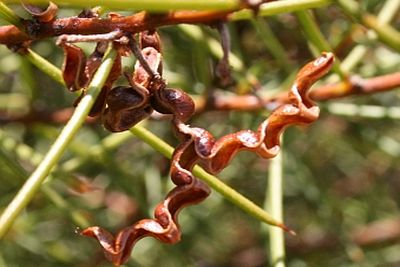
Jumping-jack Wattle forms a dense multi-branched, prickly shrub about 1.5 metres tall spreading out to 2 metres across. It has distinctive zig-zag shape seed pods resembling a 'jumping jack firecracker’ which is believed to be the source of its common name.
Jumping-jack Wattle has modified leaves (phyllodes) which are narrow, straight and ridged with more than one main vein per face, length 2 to 4.5 cm, almost cylindrical about 1mm wide, sometimes sticky, aromatic and terminating with a sharp point. Flowers, either solitary or paired are supported by a hairy, axillary peduncle (stem) and are golden yellow, globular shaped to about 4.5mm wide. Seed pods are a distinctive zig-zag shape, cylindrical and about 2cm in length by 2mm wide (Costermans 1981, Entwisle et al. 1996)
Distribution
Jumping-jack Wattle is only found in the southern part of mainland Australia where it has a patchy distribution in the Wimmera area of western Victoria and adjacent areas of South Australia, also on the Eyre Peninsula and Yorke Peninsula in South Australia.
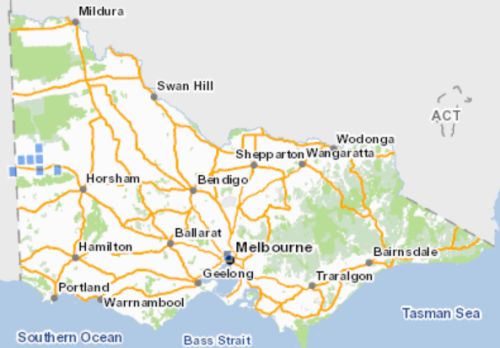
In Victoria, Jumping-jack Wattle is mainly confined to only a few sites in the Dipura/Broughton area of the Wimmera on the northern Lawloit Range (roughly between Nhill, Kaniva and Broughton), most sites are in the Wimmera bioregion with one site in the Little Desert National park in the Lowan Mallee bioregion (Stuwe 1980, FIS 2005).
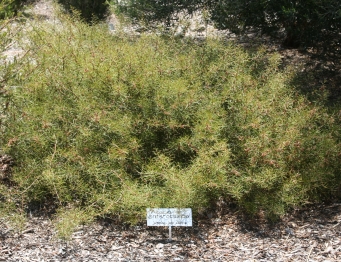
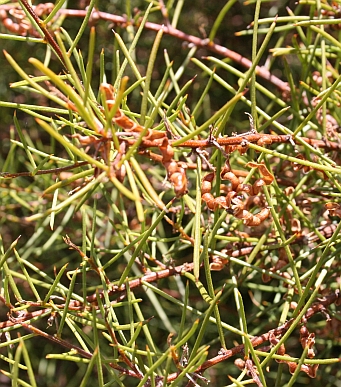
Jumping-jack Wattle plant form. Image: D. Brennan.
Ecology & Habitat
Jumping-jack Wattle has been recorded in a variety of habitats where rainfall is less than 500mm. In the Wimmera it can be found growing as a shrub layer on duplex and gradational soils which support Buloke woodlands (Morcom & Westbrook 1998). It has also been recorded growing in association with Mallee Broombush Melaleuca uncinata on the highest parts of the northern Lawloit Range on gravelly duplex ironstone soils and Mallee scrub and grassy woodlands of Yellow Gum Eucalyptus leucoxylon, Grey Box Eucalyptus microcarpa and Buloke Allocasuarina luehmannii on more fertile, brown loamy soils (Stuwe 1980).
Flowering occurs from July to September (Entwisle et al. 1996), but may extend from May to October (Overman & Venn 1999). Distinctive zig zag seed ponds are evident from December through the summer months.
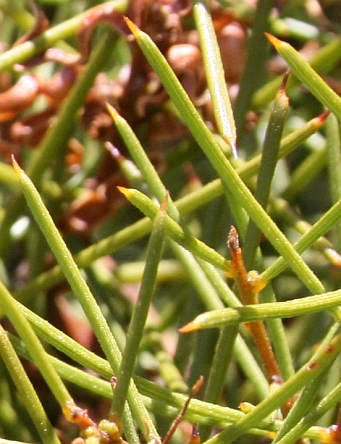
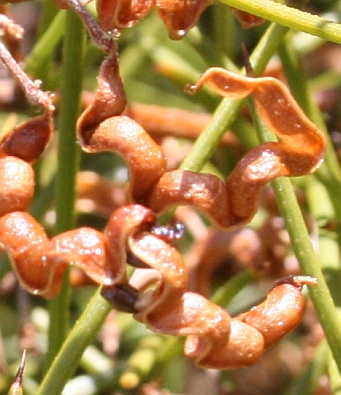
Enlarged view of open seed pod. Image: D. Brennan.
Population Status
There could be as few as 1000 plants in Victoria (Department of Environment & Heritage 2007), these being confined to several discrete areas.
Threats
One of the main threats to this species has been its loss through clearing and grazing which mostly occurred prior to an understanding of the species status. Approximately 95% of Wimmera Plain freehold land has been cleared and cultivated (Morcom & Westbrook 1998), this has resulted in a sever depletion of Jumping-jack Wattle with remnant populations now mostly confined to pockets of public land. Protection of known populations has improved in recent years with increased awareness and formal reserve status at some sites which affords an increased level of protection.
Gall infestation has been identified as a high level threat to all populations, and was found to be a major limiting factor in the revegetation of the Diapur Flora Reserve in the 1970s (Overman & Venn 1999).
Conservation & Management
Protection of populations on road and rail reserves together with those in Flora reserves now provides a stable platform for recovery of this species, however the populations are still small and fragmented and require ongoing monitoring and management. Jumping-jack Wattle can be easily propagated and is now sold in plant nurseries in the Wimmera. This species is now widely used in revegetation projects which should assist the establishment of new populations.
Conservation of Jumping-jack Wattle in Victoria
- A draft translocation plan has been written for this species.
Key Local Government Areas
- Horsham Rural City
- West Wimmera Shire
- Hindmarsh Shire
Reintroduction
- Identify potential sites for reintroduction / translocation and revegetate the species on five suitable sites through local seed collection, propagation and horticulture. Utilise the gall free plants in the Lonsdale Block plantation as a genetic resource for comparison with infected plants and as a possible seed source if the origins can be confirmed.
- Two sites have been identified for reintroduction and translocation; the Mirampriam Flora Reserve and a privately owned Trust for Nature covenanted property.
- In 2011 a translocation of 293 plants occurred with the assistance of International Student Volunteers (ISV) on a privately owned Trust for Nature covenanted property near Broughton-Yanac. Monitoring in February 2012 revealed that 84% of the plants were still alive. Monitoring undertaken in 2017 found that 42 of the original 293 plants were alive, giving a survival rate of 14.5%.
- Translocation of 95 plants was undertaken in 2015, on the same privately owned Trust for Nature covenanted property as the 2011 translocation project. 48 of 95 plants were found to be alive during monitoring in 2017, giving a survival rate of 50.5%.
Research
- Investigate the nature and cause of gall infestation and methods to prevent its damage and spread. (completed)
- Conduct survey to confirm all existing records and identify all sites on public and private land. (In 2011/12 a new population was discovered on private property north of the Little Desert).
- Population monitoring protocols developed by DELWP.
- Test a range of alternative management regimes at several sites (see trial at Mirampiram Flora and Fauna Reserve).
On-ground protection
- Erect/maintain fences to exclude domestic stock and protect sites from seasonal droving.
- Raise public awareness of the species and its significance and involve community groups and volunteers in recovery activities.
- Identify all sites and liaise with landholders/land managers on public and private land, and negotiate the protection of the sites, provide management advice and erect signs at roadside sites.
- Seed has been collected for the Millennium Seed Bank Project, Royal Botanic Gardens from the Jumping-jack Wattle Nature Conservation Reserve.
-
Rust has been administered to control Bridal creeper and rabbits fumigated at multiple roadside populations.
-
It is recommended that grazing pressure be assessed and managed as part of translocation or burn programs for Jumping-jack Wattle.
Projects & Partnerships
Mirampiram Flora and Fauna Reserve (near Sandsmere) – Managed by Parks Victoria
- Investigate the use of fire as a management tool to promote regeneration from soil stored seed-bank.
- Identify fire management priorities and develop a detailed plan (A small trial plot within the Mirampiram Flora and Fauna Reserve was burnt in 2011 to promote recruitment. Post-burn, germination was observed with high germination levels of Acacia enterocarpa, though these were heavily grazed upon by rabbits due to inadequate rabbit protection and control.
- Prevent habitat loss through protection of habitat from threats such as grazing, rabbits and weeds. Undertake fire protection, and continue to revegetate the site with indigenous species. Ensure that grazing pressure is assessed and managed as part of translocation or burn programs.
- DELWP to conduct annual survey and monitoring of all known sites, investigate reports of other populations, and ensure all monitoring data is included on Flora Information System databases.
Diapur Reserve – Managed by Parks Victoria
- Investigate the use of fire as a management tool to promote regeneration from soil stored seed-bank.
- Control environmental weeds at Site 6 in Diapur.
- DELWP to conduct annual survey and monitoring of all known sites, investigate reports of other populations, and ensure all monitoring data is included on DSE databases.
- DELWP -Reserve part of the Water Reserve at Diapur and two roadside sites along the Kaniva-Broughton Road to protect Jumping-jack Wattles.
Trust for Nature covenanted properties
Translocations have taken place on two privately owned Trust for Nature covenanted properties in 2011 and 2015.
Local Government
- West Wimmera Shire and Hindmarsh Shire in protecting roadside sites.
Parks Victoria
- Little Desert National Park, Diapur Reserve, Mirampiram Flora Reserve.
Conservation groups
- Wimmera Growers of Australian Plants.
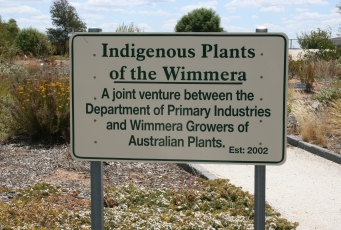
References & Links
Costermans, L.F. (1981) Native trees and shrubs of south-eastern Australia, Rigby Publishers Ltd.
Department of the Environment and Heritage (2007). Acacia enterocarpa in Species Profile and Threats Database, Department of the Environment and Heritage, Canberra. Available from: http://www.deh.gov.au/sprat. Accessed 3/1/2007. [http://www.deh.gov.au/cgi-bin/sprat/public/publicspecies.pl?taxon_id=17615 DEH - Species profile]
Entwisle, T.J., Maslin, B.R., Cowan, R.S. & Court, A.B. (1996) Flora of Victoria Vol 3, p614. Ed. Walsh, N.G. & Entwisle, T.J., Inkata Press, Melbourne.
FFG Threatened List 2023, Department of Energy,Environment and Climate Change (DEECA), June 2023.
FIS (2005) Flora Information System, Department of Sustainability & Environment, Victoria.
Morcom, Lisa A. & Westbrooke, Martin E. (1998)The Pre-Settlement Vegatation of the Western and Central Wimmera Plains of Victoria, Australia. Australian Geographical Studies 36 (3), 273-288. doi: 10.1111/1467-8470.00057
Overman, T. & Venn, D (1999) Flora & Fauna Guarantee Action Statement No. 85 Jumping-jack Wattle, Department of Sustainability & Environment, Victoria. (now Department of Environment, Land, Water and Planning). DSE - Flora & Fauna Guarantee Action Statement No.85 pdf
Stuwe, J. (1980) Rare and endangered Victorian plants, Acacia enterocarpa, Victorian Naturalist Vol. 97, 157-158.
VBA (2019) Victorian Biodiversity Atlas, 2018. Department of Environment Land, Water and Planning, Victoria.
More Information
World Wide Wattle – Acacia enterocarpa
Please contribute information regarding Jumping-jack Wattle in Victoria - observations, images or projects. Contact SWIFFT

